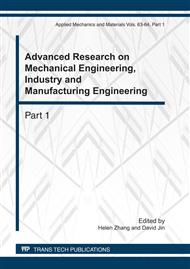[1]
Li Gao, Hongzhi Liu. Research to Quality Assessment Model for Information Engineering Surveillance Based on HMM [C]. The Sixth Academic Annual Conference of National Multi-Agent System and Control, National Defense Industry Press, 2010: 258-261. (in Chinese).
Google Scholar
[2]
Hongzhi Liu, Congcong Zhang. RESEARCH ON INFORMATION ENGINEERING SURVEILLANCE RISK EVALUATION BASED ON FAULT TREE ANALYSIS. Proceedings 2010 3rd IEEE International Conference on Computer Science and Information Technology, July 7-10, 2010 Chengdu, China. pp.601-605.
DOI: 10.1109/iccsit.2010.5564424
Google Scholar
[3]
Hongzhi Liu, Rongyan Yang, Haisheng Li, Ying Liu and Dagao Duan. The Research of Surveillance and Evaluation of E-government Project Quality. 2009 International Conference on Information Engineering and Computer Science. VolumeⅢ. December 19-20, 2009 Wuhan, China, p.1935-(1938).
DOI: 10.1109/iciecs.2009.5363377
Google Scholar
[4]
Tao Longming, Shi Zhicai. Application of HMM to Detecting Sophisticated Network Attacks [J]. Computer Engineering and Applications, 2008, 44 (7) : 136- 138. (in Chinese).
Google Scholar
[5]
Dong Jing. Research on the Improvement of HMM Method in Risk Assessment to Network Security [D]. Huazhong University of Science and Technology, 2008. 6. 3. (in Chinese).
Google Scholar
[6]
Hyeon-Kyu Lee and Jin H. Kim. An HMM-Based Threshold Model Approach for Gesture Recognition[J]. IEEE Transactions on Pattern Analysis and Machine Intelligence, Vol. 21, No. 10, pp.961-973, October. (1999).
DOI: 10.1109/34.799904
Google Scholar
[7]
Li Gao, Hongzhi Liu. Application of Hidden Markov Model in Information Engineering Quality Surveillance [J]. Microcomputer & its Applications, 2010. 11, Vol. 29, No. 317: 91-93. (in Chinese).
Google Scholar
[8]
Hong Liu, Zhang Wei. An Improved Information Extraction Model Based on HMM [J]. Pattern Recognition and Artificial Intelligence, 2004, Vol. 17, No. 3. (in Chinese).
Google Scholar
[9]
Liu Qing, Yan Xiangdong. Design and Realization of Genes Recognizing System Based on Hidden Markov Model [J]. Computer Engineering and Applications, 2003, Vol. 24. (in Chinese).
Google Scholar


